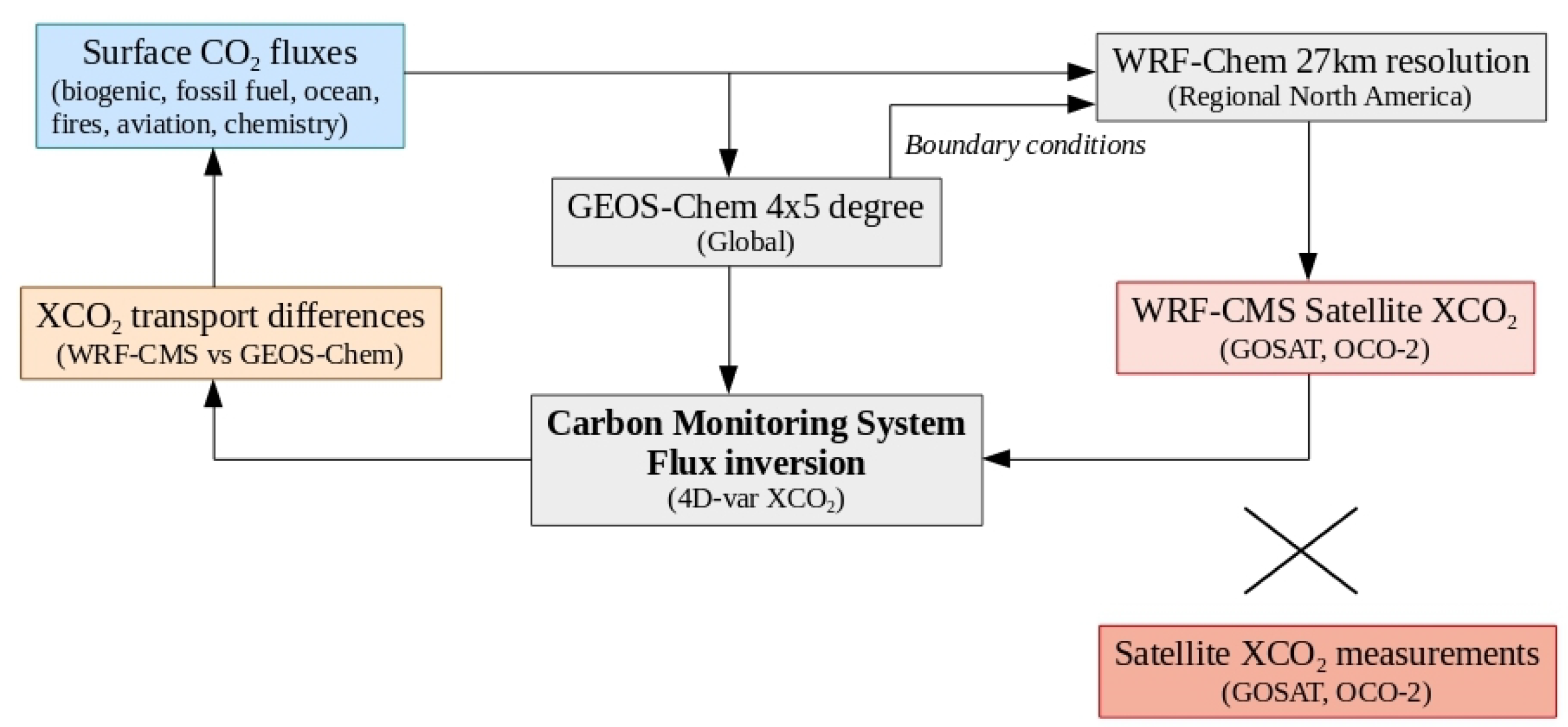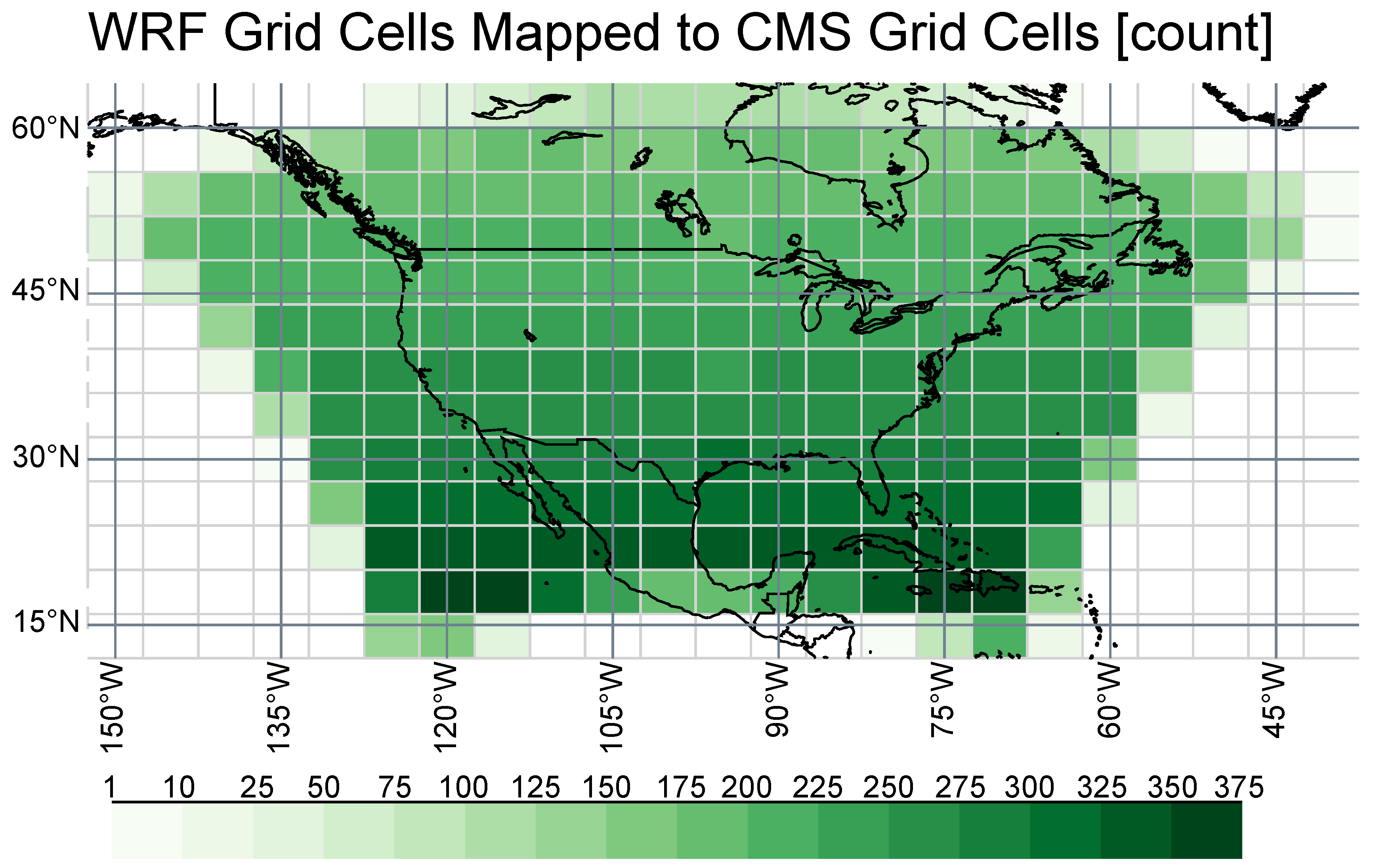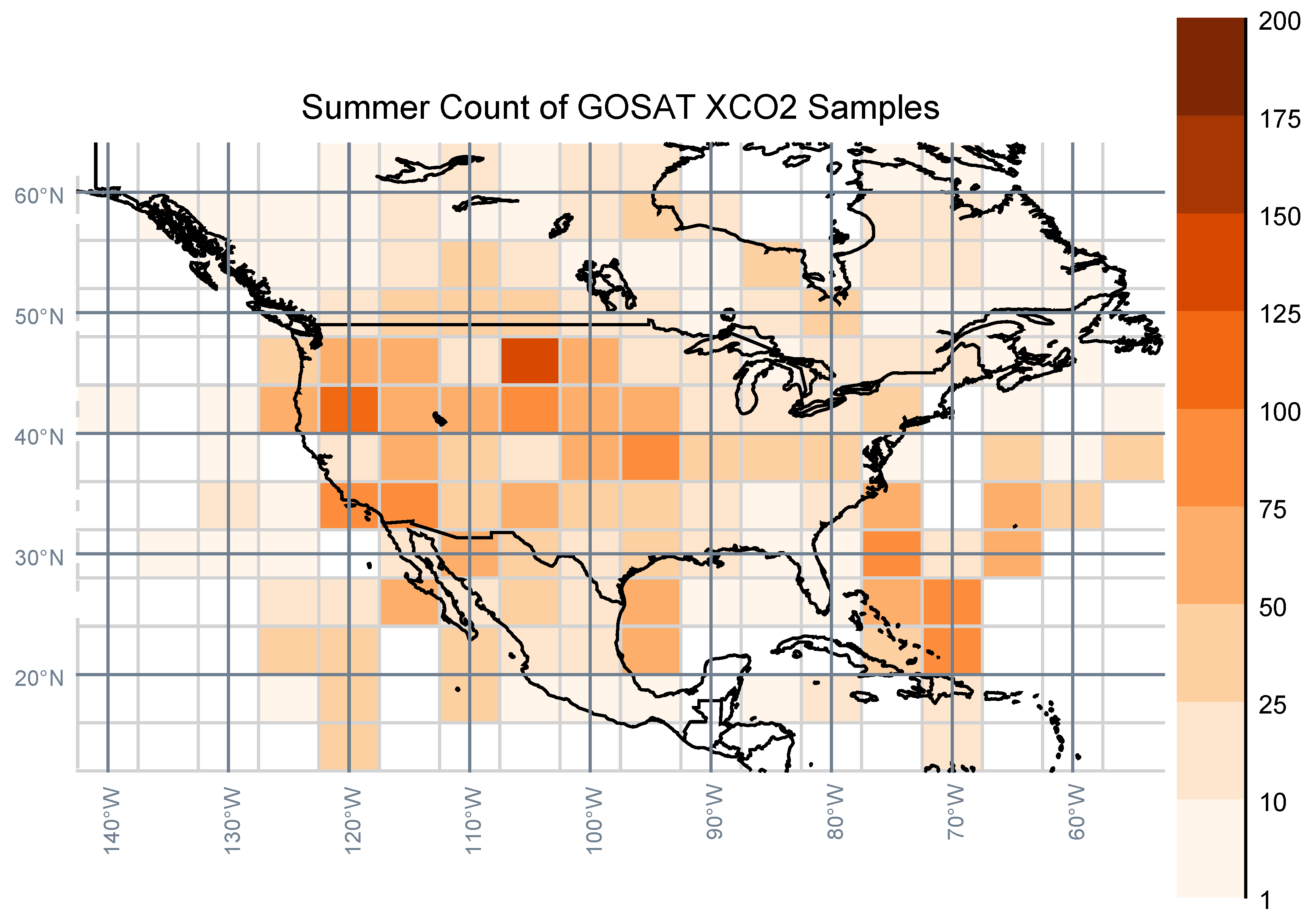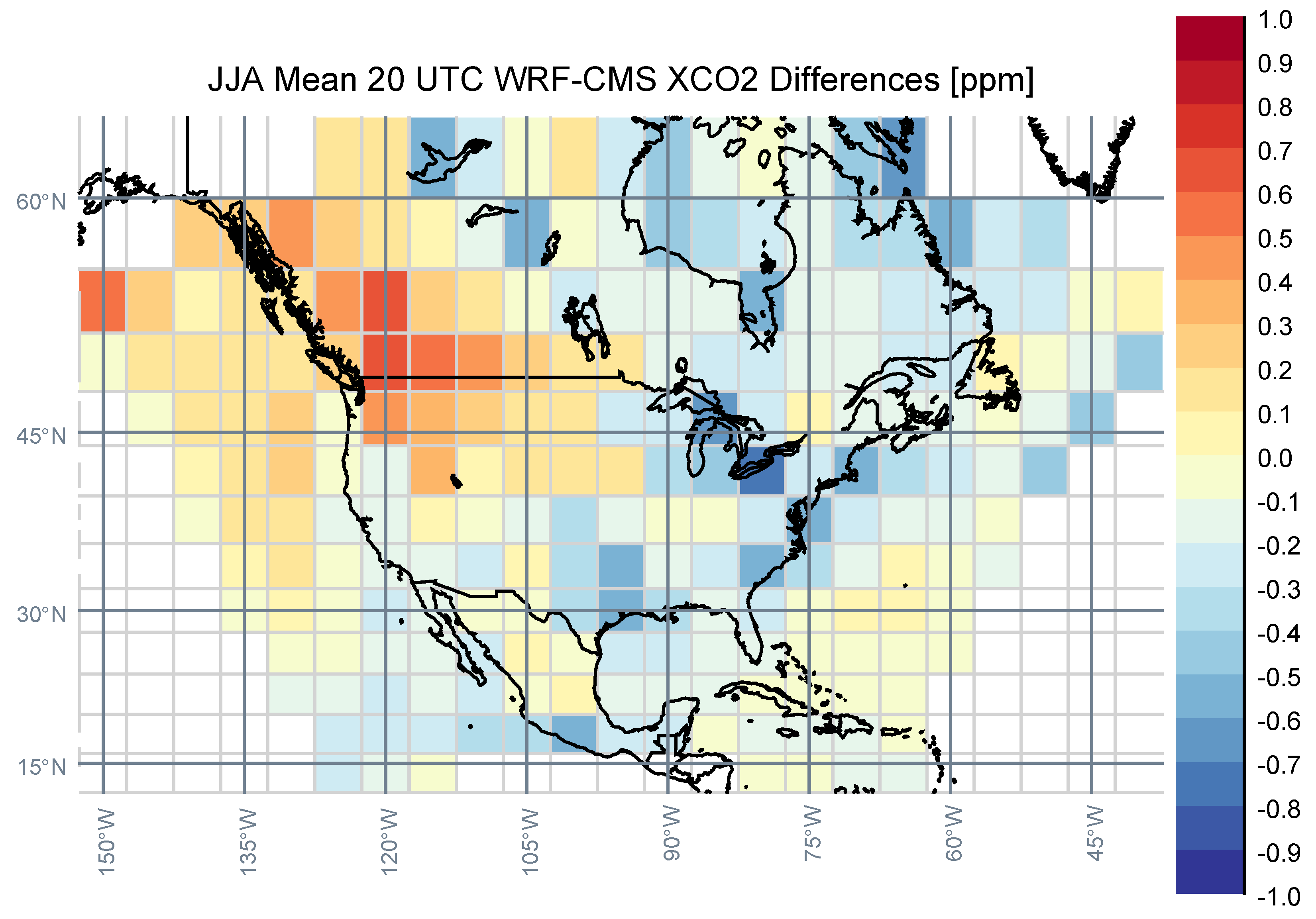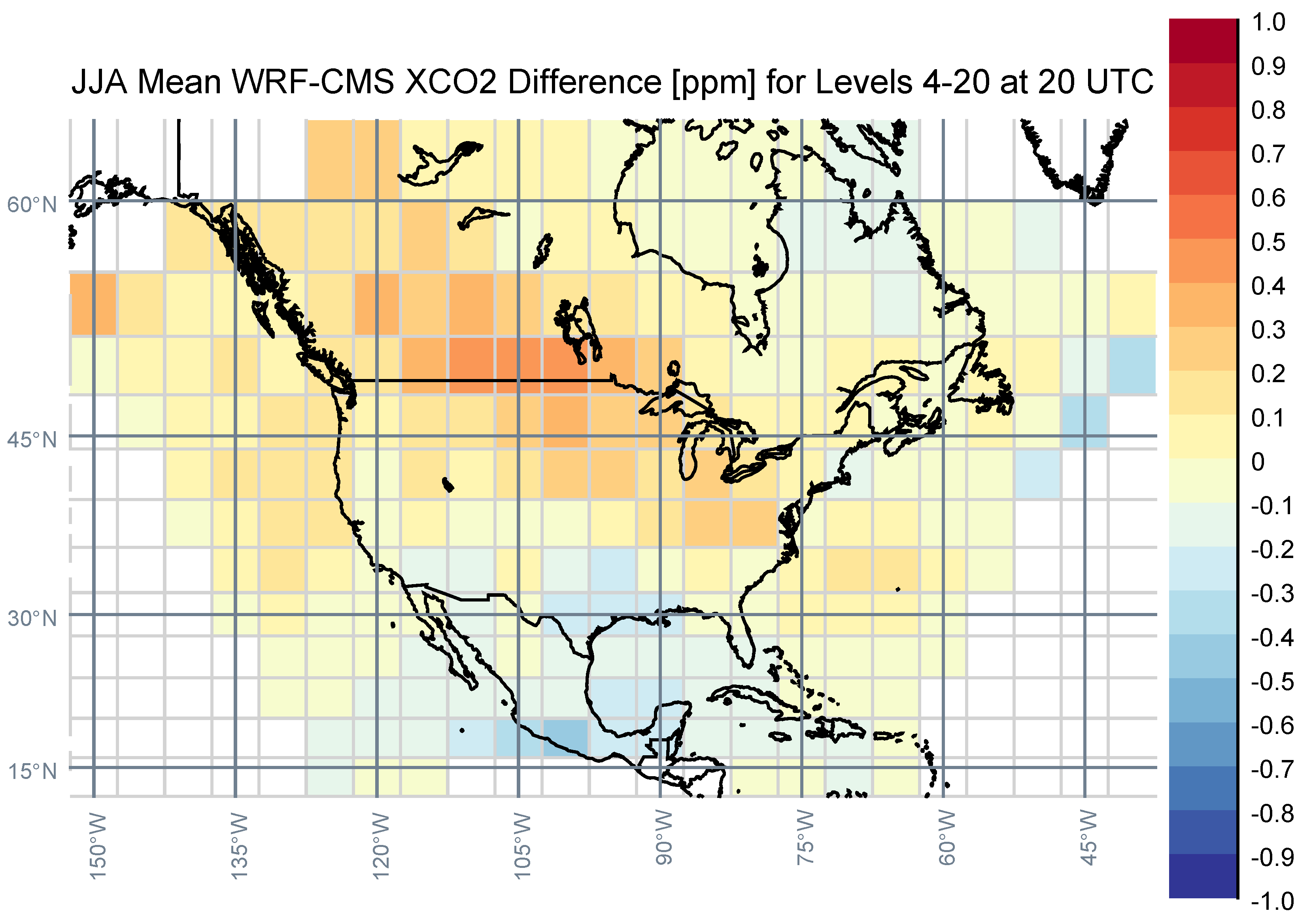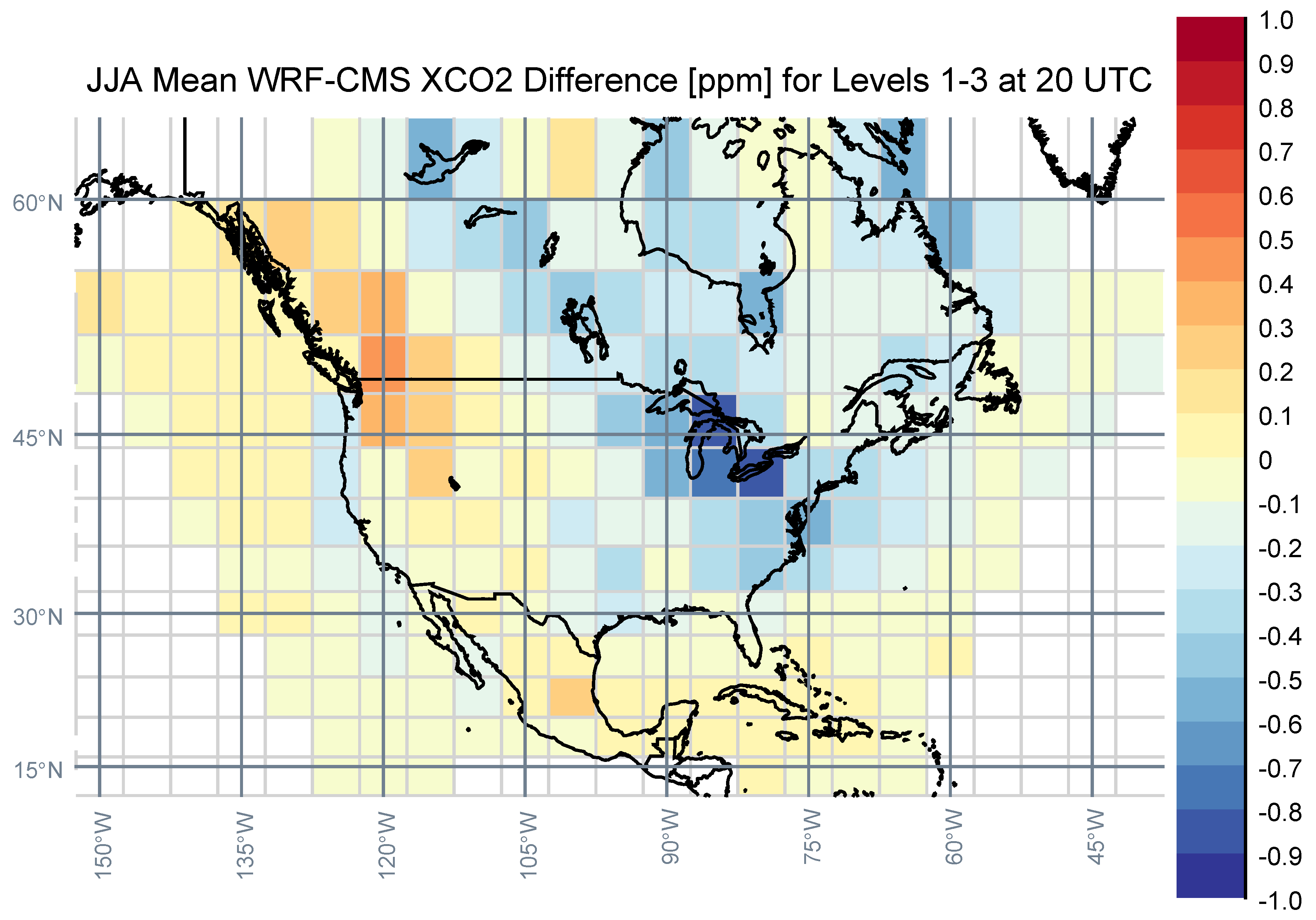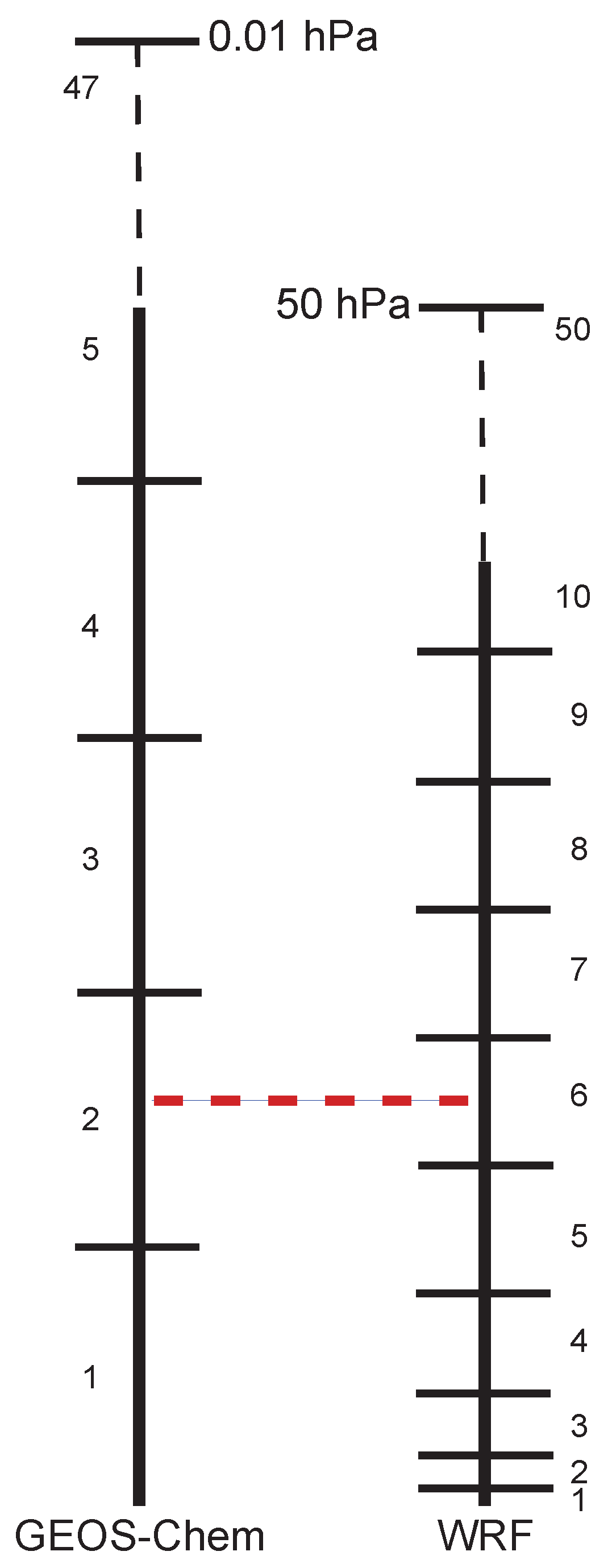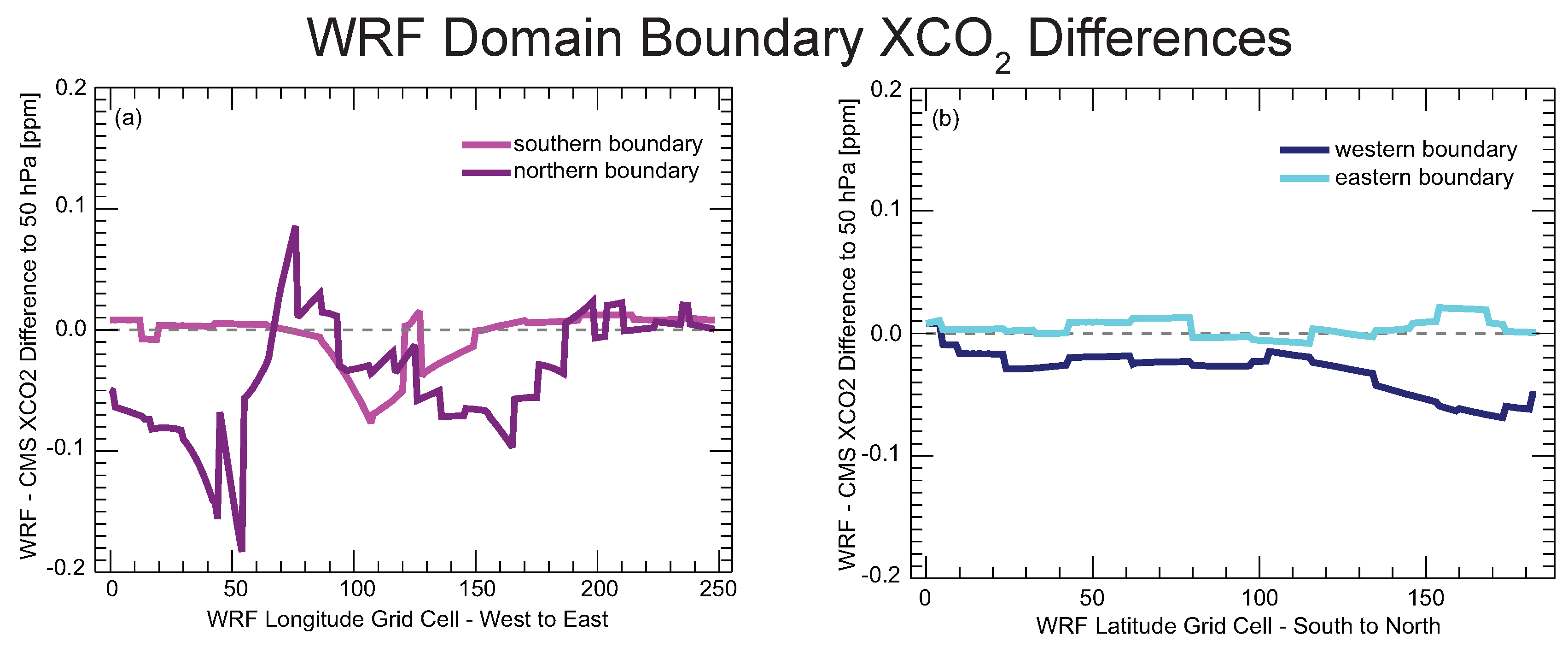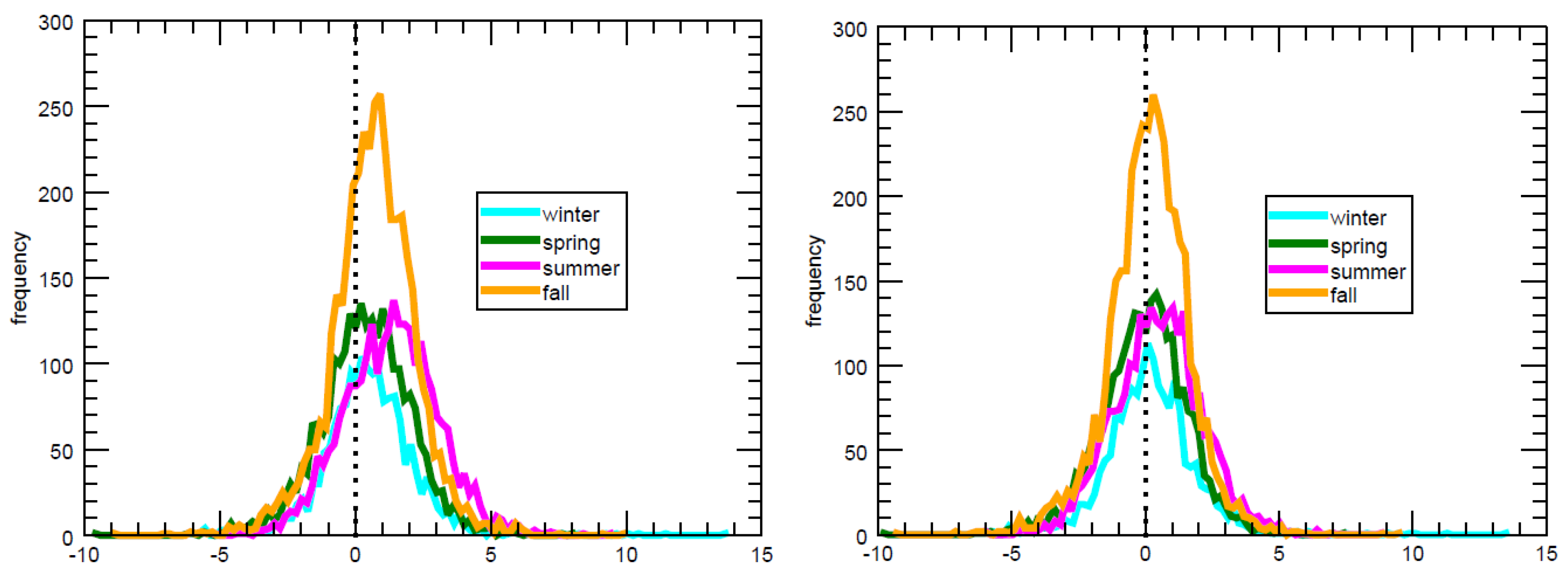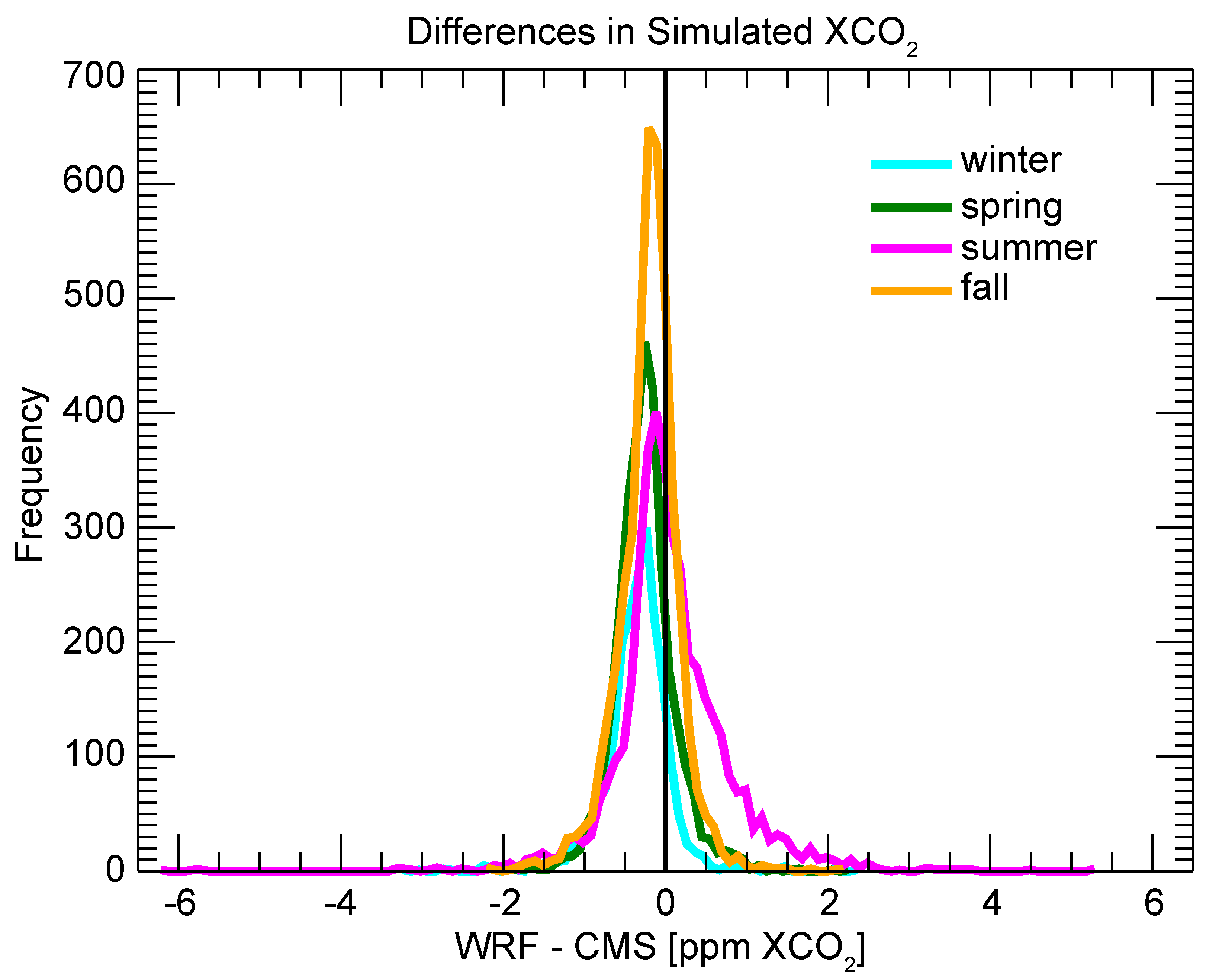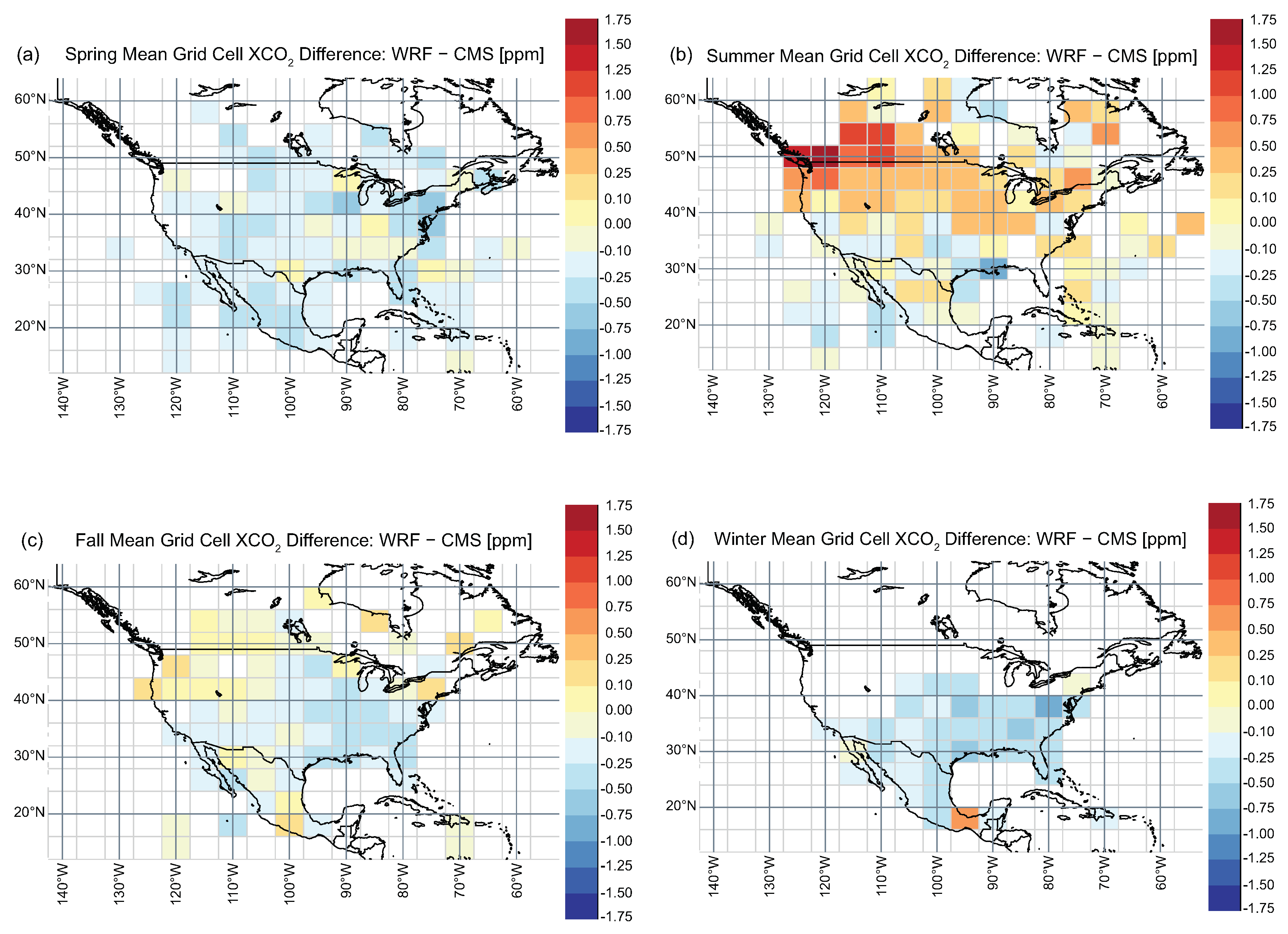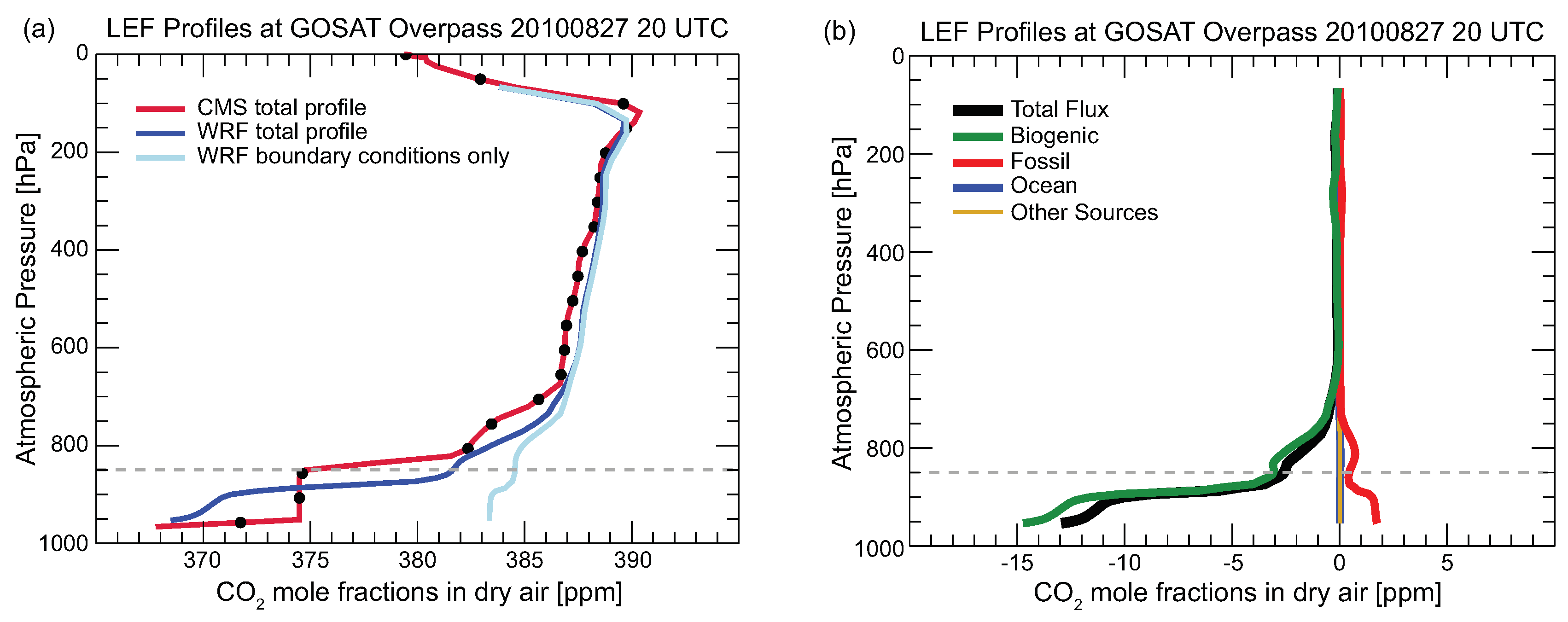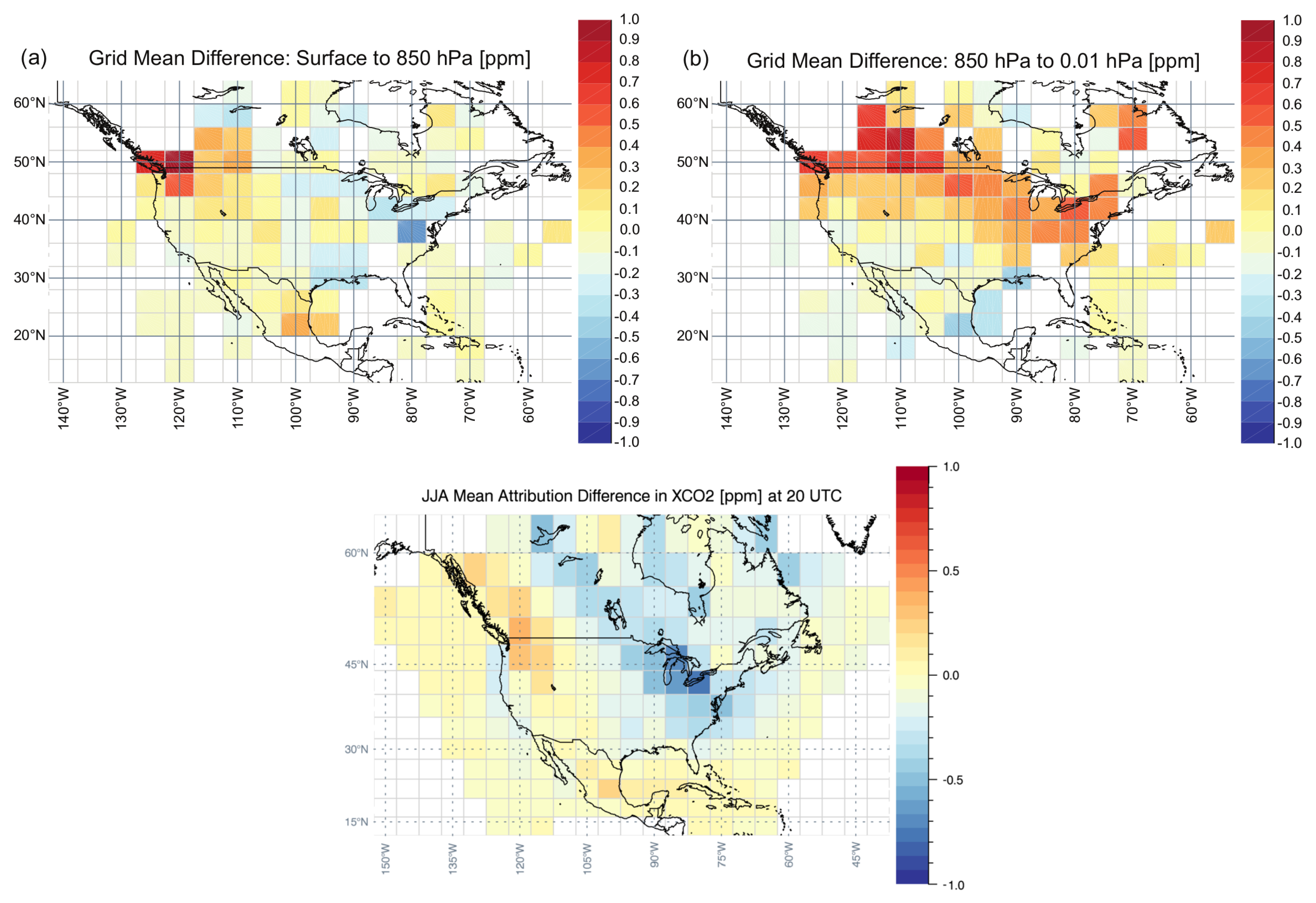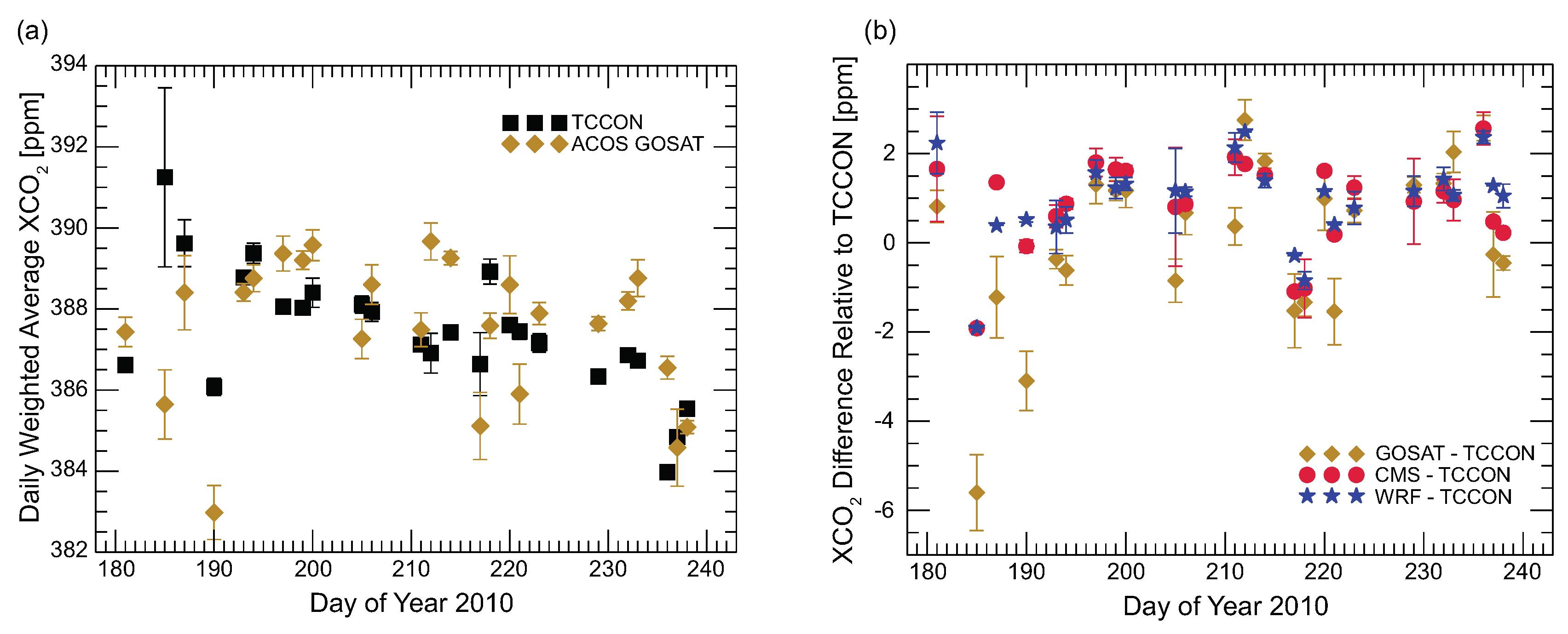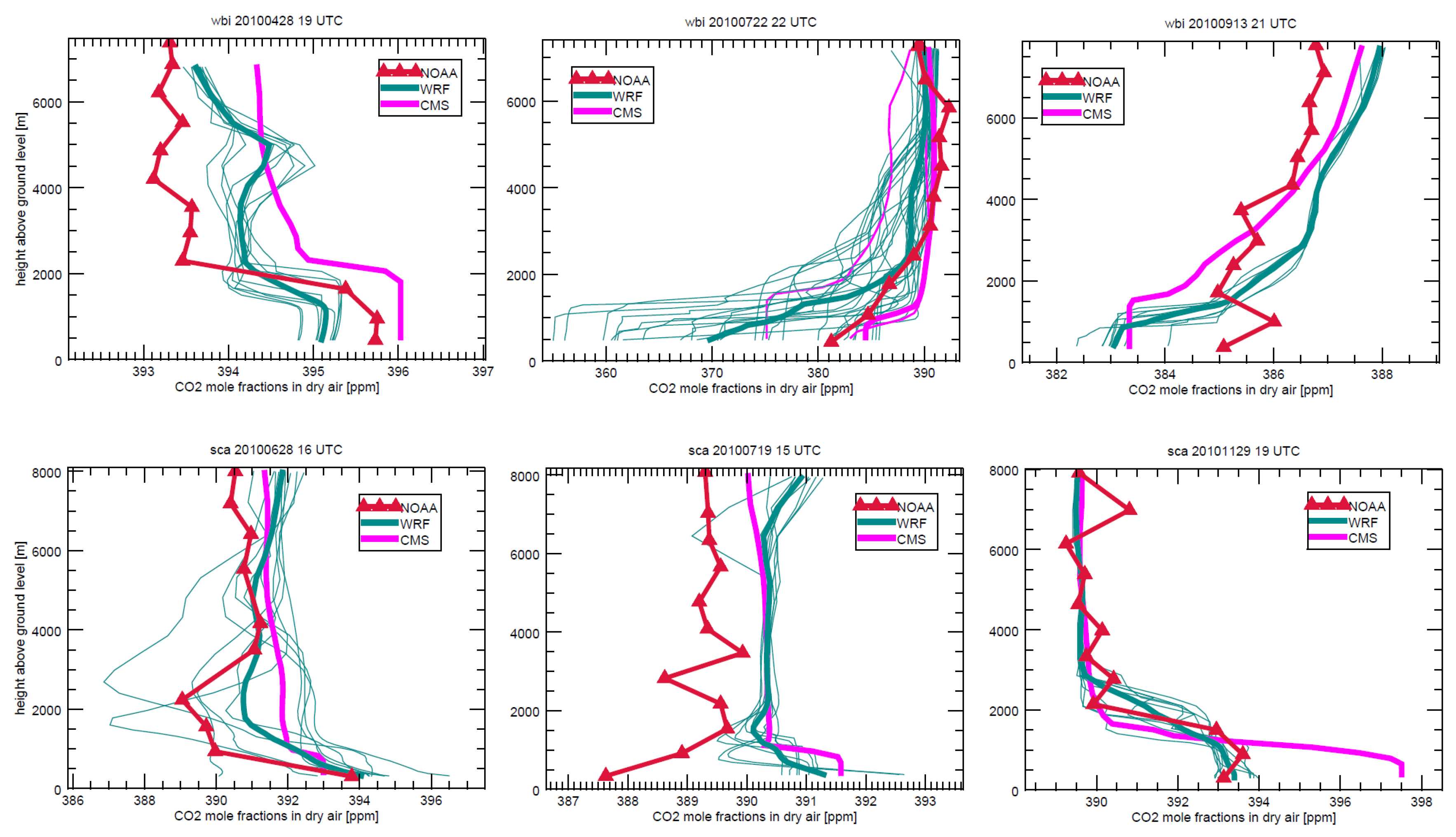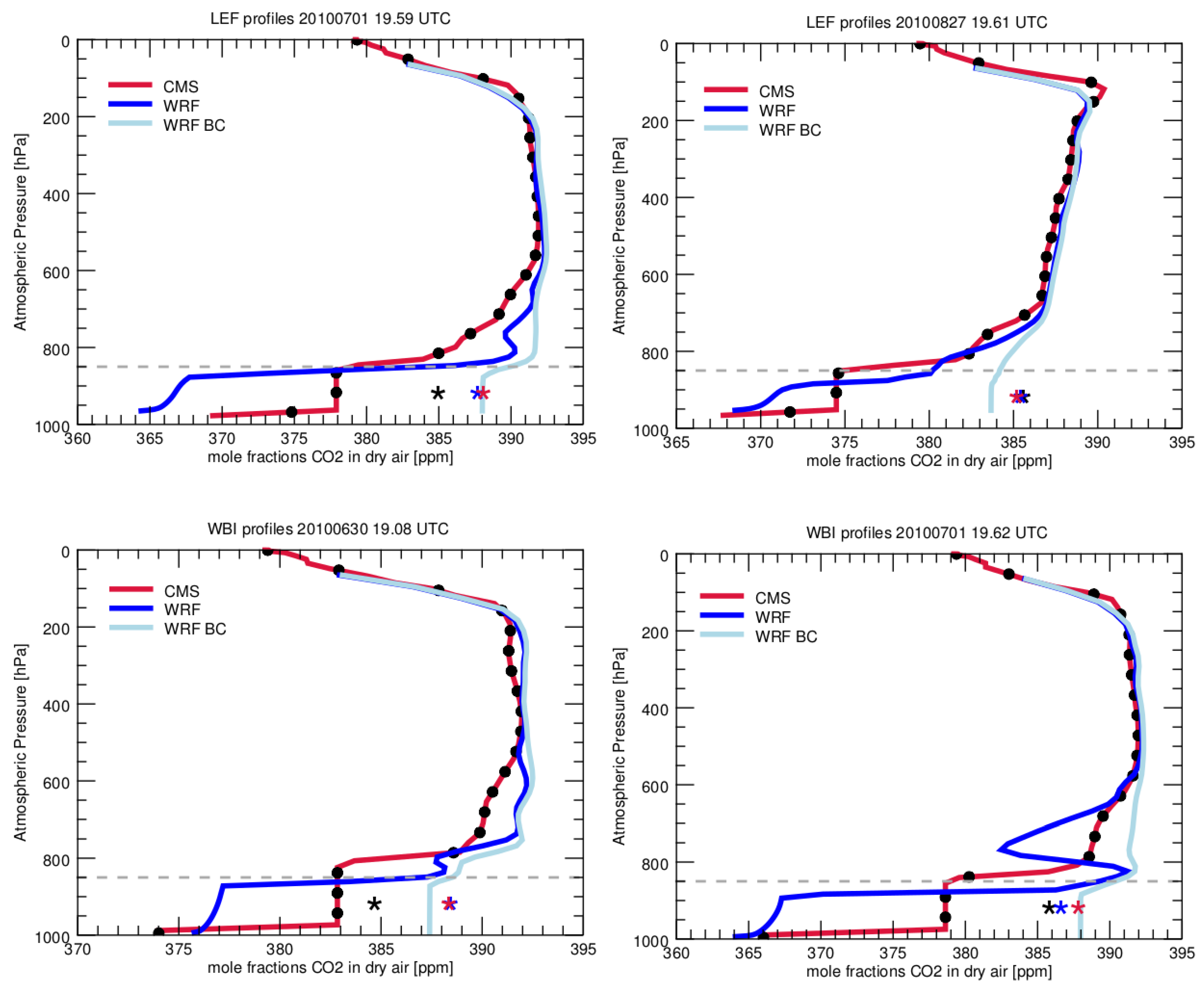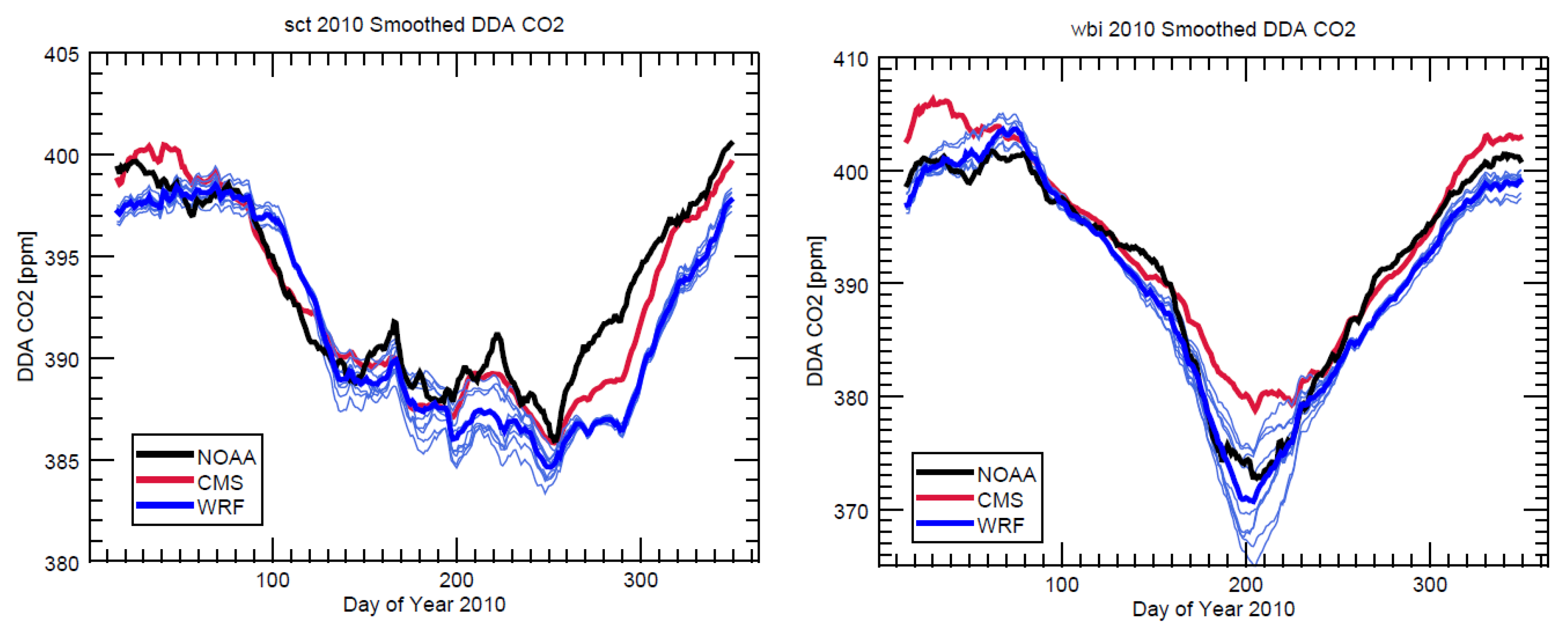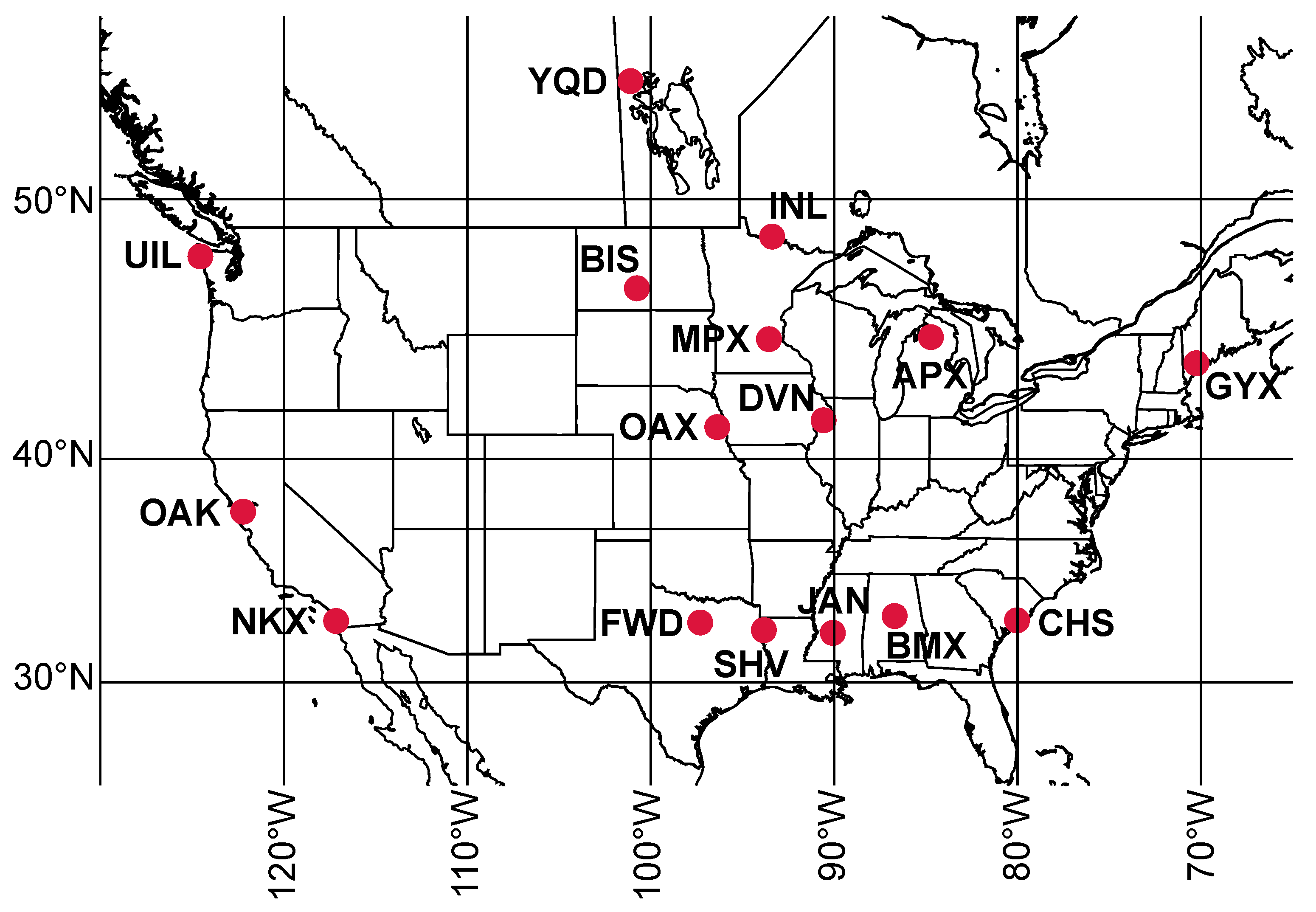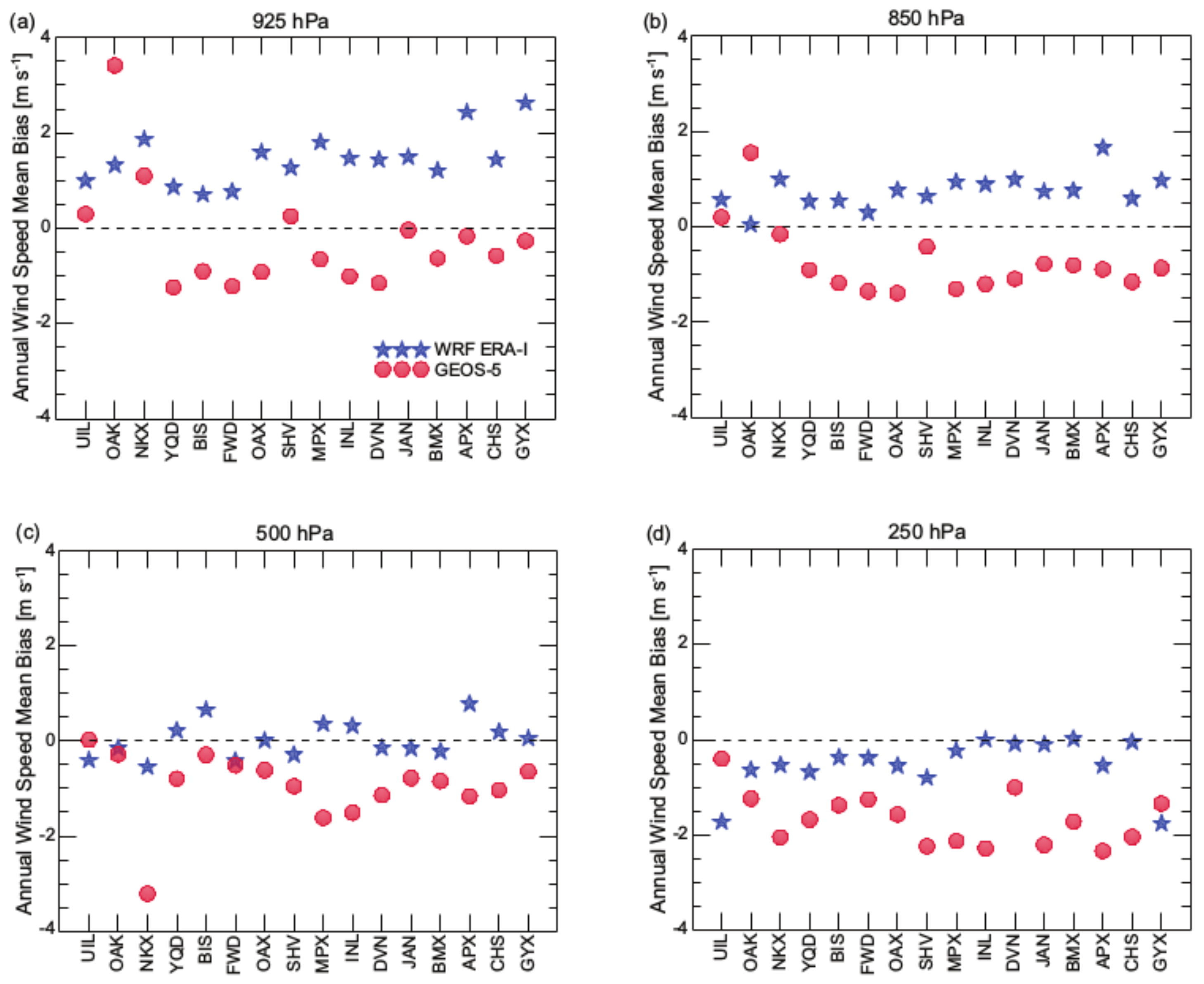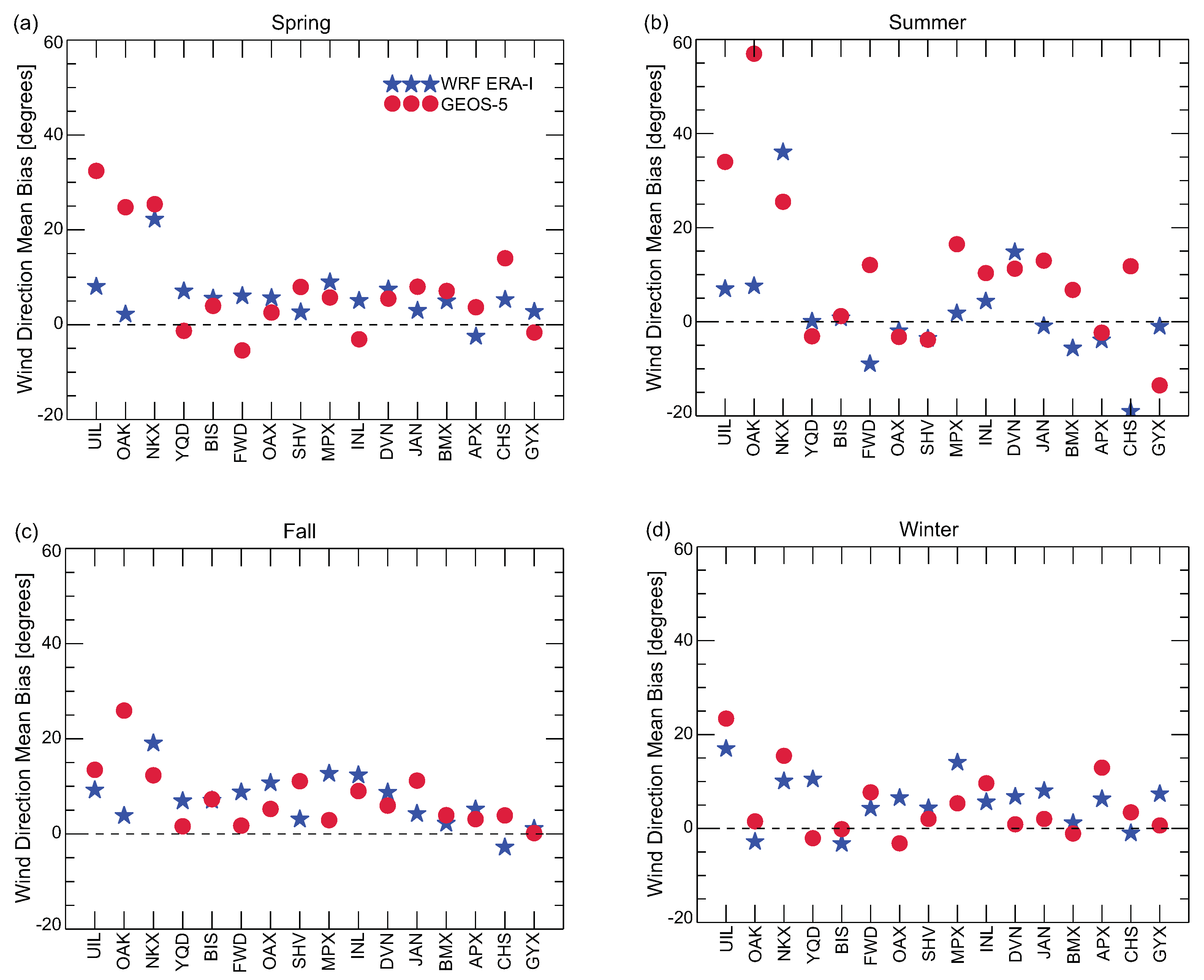1. Introduction
One of the persistent challenges in the study of the global carbon cycle is the quantification of the uncertainty in inferred biogenic carbon sources and sinks [
1]. Contemporary solution methods include atmospheric inversions while using general circulation models and in situ or satellite observations of carbon dioxide (
) to correct vegetation model or flux-derived estimates of these biogenic surface
fluxes e.g., [
2,
3,
4]. However, in spite of increasing sophistication in the optimization methods and observation systems, annual inverse fluxes vary widely at continental scales, e.g., from 0 to −1.5 PgC over North America [
5]. Recent studies e.g., [
6] assimilating in situ and satellite retrievals from the Orbiting Carbon Observatory (OCO)-2 NASA mission estimated the range of uncertainties between −0.5 to −1.6 PgC over North America. Contributions to this disagreement include poor representation of the heterogeneous land surface in relatively coarse general circulation models [
7], as well as aggregation and atmospheric transport errors [
8]. Inversions using column-averaged
(
) show promise [
9] as the
from satellites are presumed to be less susceptible to planetary boundary layer (PBL) atmospheric dynamics and heterogeneous surface fluxes [
10,
11]. Assimilating column-averaged
observations is not without problems in terms of seasonal global coverage, interference from clouds, and large-scale transport errors [
12]. The density of observations increases to unprecedented levels, requiring averaging or thinning techniques, so that global inverse models can ingest the large volume of data collected monthly [
9]. An increase in atmospheric model resolution would potentially provide a better representation of the observed spatial variability in
over continents and allow for the assimilation of individual satellite retrievals [
13], and may become even more important for the use of observations from geostationary satellites [
14].
Regional models, which are capable of transporting
as a trace gas, have been effectively used to simulate atmospheric
gradients in regional studies [
15,
16] and generate footprints or back trajectories from observation locations to correct in-domain
surface fluxes in comparison to existing agricultural inventories e.g., [
7,
17]. Several studies illustrated the value of regional models in exploring the near-field variability of
fluxes and observed mole fractions, using a biogeochemical flux model coupled to a mesoscale atmospheric model and lateral boundary conditions modified from a global model [
15,
18,
19]. However, these uses of regional models often assume that the large-scale boundary inflow is sufficiently known, so that fluxes within the regional domain dominate the observed variability e.g., [
20,
21]. To deal with total observable mole fractions of long-lived trace gases, background mole fractions (advected from outside the regional domain) must be dealt with carefully, e.g., [
22]. Various strategies are in use; some are borrowed from the discipline of atmospheric chemistry research: constant concentrations [
15], profiles from aircraft sampling, vertical transects derived from global models, and data over oceans [
23], climatologies or average conditions from global models (see Tang et al. [
24] for a review). For short campaigns, aircraft profile sampling can establish a curtain wall of boundary conditions in the upwind direction. Profile sampling schemes can be used to correct climatological conditions using monthly mean values. These climatologies or average conditions may be used for short-lived trace gases e.g., [
25], but they do not fairly represent varying atmospheric circulation and transport. For long-lived trace gases, such as
, the vast majority of the molecules in any given volume is the result of long-range transport that originates outside the simulation domain.
Long-running regional
inversion studies require time-varying, full-pro has been inversion-optimized mole fractions from global models, with and without adjustment to account for biases in the global model. For example, Göckede et al. [
20] and Göckede et al. [
21] used four-dimensional (4-D) lateral boundary conditions from the CarbonTracker global model [
26] and verified the high sensitivity of regional inverse fluxes to the
advected at the lateral boundaries. Bias-correcting offsets or adjustments to global model mole fractions have also been made based on comparisons to remote clean-air observations [
27]. Lauvaux et al. [
28] used a two-step approach, first adjusting the modeled mole fractions with local aircraft profiles and, second, optimizing them within the inversion system. Gourdji et al. [
29] compared inversion results using an empirical data product that was derived from Pacific Ocean marine boundary layer observations and aircraft profiles [
30,
31] following Gerbig et al. [
32] and described in Jeong et al. [
33]. Ahmadov et al. [
18] and Ahmadov et al. [
19] incorporated
initial and lateral boundary conditions from a global model (LMDZ; Peylin et al. [
34]). Their lateral boundary conditions consisted of the results of a forward run of surface fluxes in LMDZ with an added constant offset to adjust the modeled
mole fractions for general agreement with European in situ observations. He et al. [
23] optimized boundary conditions using upper-air aircraft profile measurements (above 3000 m asl) while using global atmospheric mole fractions from a global inversion system and data-driven vertical transects.
In our study, we assume the optimized mole fractions from the global model can be used without further adjustment. We also choose the regional domain boundaries to be remote from the main area of interest in our study, and aim to conserve the mass of
introduced at the boundaries of the simulation domain to be consistent between the global model and the regional model. This enables us to simulate column-averaged
(
) in both global and regional models and compare to satellite-derived observations. This permits us to explore the impact in the regional model of surface
fluxes optimized in the global model. To better understand the role of transport errors in our simulations, we also perform an ensemble of Weather Research and Forecasting-Chem (WRF-Chem) simulations while using identical fluxes from the NASA Carbon Monitoring System-Flux (CMS-Flux) inversion system but different transport realizations using the Stochastic Kinetic Backscatter Scheme (SKEBS; Berner et al. [
35]). Do these fluxes produce equivalent results in the regional domain? How large are the differences in simulated
due to the use of different atmospheric transport models? Are the transport errors impairing our ability to infer surface sources and sinks? These are long-standing problems in
inversion studies.
In our experiment, we introduce the optimized biogenic surface fluxes and posterior 4-D atmospheric mole fractions of
from the Carbon Monitoring System (CMS-Flux; Liu et al. [
36]) as initial and boundary conditions into the WRF-Chem regional model [
37,
38,
39]. Here, we describe this framework for achieving our goal of conserving the mass of
introduced in the regional model from the global model. In
Section 2, we describe the global and regional models used in this experiment, the model coupling framework, and introduction to the methods for comparison to observation data. We present between-model consistency and comparisons to observations in
Section 3. A discussion of the results follows in
Section 4. Finally conclusions are presented in
Section 5, including how the framework can be used to couple other global models to WRF.
4. Discussion
Based on the spatiotemporal distribution of GOSAT
soundings, there is very good agreement between the two modeling systems and GOSAT in the gross seasonal comparisons, well within the uncertainty of the individual GOSAT retrievals (0.5–2.00 ppm, reported with each sounding). Our primary goal of this framework is to control the
mole fractions introduced into the WRF domain to be as close as possible to the mole fractions from the global model. By scaling the surface fluxes and constraining the mole fractions in the flow at the boundary walls, we have approached this goal of mass conservation. The largest spatiotemporal differences in
shown in this experiment appear to be due to the model–model differences in transport of the anomalous July biogenic source in the continental northwest and offsetting sinks in the midwest and east in the optimized CMS-Flux biogenic fluxes. However, the very small differences in simulated
values mask larger differences within the columns. For example, we can see model-model differences in the transport of the surface flux anomaly in the Pacific Northwest in summer, both within and above the boundary layer (
Figure 7). Apparent model differences in vertical mixing within the boundary layer in summer in the eastern part of North America result in lower values within the boundary layer (<850 hPa, −0.5 to +0.1 ppm) and higher values above the boundary layer (>850 hPa, by +0.1 to +0.5 ppm) in the mesoscale model compared to the global model. We know that this configuration of WRF-Chem lacks convective mass transport of the
tracers. This will affect the vertical transport of
into and out of the boundary layer. We also acknowledge here that diurnal variations in CMS surface fluxes are prescribed and they might not exactly match the meteorological conditions in WRF. A comparison of fluxes and PBL variations at shorter timescales is needed in future studies, and might be optimized in the inversion systems e.g., [
23]. The CMS-Flux optimized
mole fractions also show effects of recent fluxes in the layer closest to the surface, and then nearly homogeneous mixing in the next several model layers, as seen in the example profile in
Figure 6a and
Figure 11.
Comparison to in situ
mole fractions collected during aircraft flights (NOAA aircraft program) showed that vertical air motion above the PBL top changes significantly the horizontal distribution of column
. When comparing
mole fraction biases at various tower locations (near the surface) to biases in column
, seasonal and regional biases appeared to contradict each other, i.e., negative biases in Summer in
while column
was positively biased. Detrainment of air out of the PBL, convection, and day-to-day PBL height variations lift up CO
2 molecules above the PBL, which are advected horizontally by fast-moving air masses in the Free Troposphere. A recent study showed the role of deep convection at Mid-latitudes by comparing two global models coupled to the same surface fluxes [
87]. Their results suggest that the transport of continental surface fluxes by latitudinal atmospheric transport can greatly impact the distribution of
mole fractions across the northern hemisphere. Similar to our results, they conclude that additional evaluation of vertical mixing is needed to reduce transport errors above the PBL, esp. by deep convection and other detrainment processes. The apparent agreement between models over the entire simulation domain was in fact hiding large differences in the vertical distribution, hence affecting the horizontal distribution of
at finer scales. The utility of aircraft data in our analysis explained some of the observed differences in column
, not visible when comparing
mole fractions at tower levels (within the PBL).
The ensemble of WRF realizations generated by perturbing the initial and boundary conditions and the model physics provided additional information on the impact of transport errors in the observed model–model and model-data differences. Seasonally, model-model differences are driven alternatively by the large-scale boundary inflow (Spring and Fall) or by the near-surface vertical mixing (Summer and Winter). Despite improving the coupling scheme with mass-conservation, differences remain between models, which are mostly due to differences in the transport of the CMS boundary conditions within the WRF simulation domain. Hence, model coupling is critical during off-seasons when signals from the surface are small, but when boundary conditions are affected by large-scale seasonal and synoptic variations. At the annual scale, transition seasons might cause the mis-attribution of large-scale inflow of into surface flux signals within the inverse system. Future studies will focus on the attribution of and model-data residuals into surface and boundary contributions.
In this experiment, the meteorological evaluation of the WRF results was approximately comparable to the GEOS-Chem GEOS-5 results, and neither compared well in all respects with the rawinsonde observations. At the selected sites, the GEOS-5 winds were slow by up to 3 ms at nearly all of the sites and mandatory levels that we used for comparison, while the WRF winds were closer to observations at higher levels. We had hoped to see better performance from the increased resolution, both horizontal and vertical, in WRF. Perhaps the horizontal resolution in WRF is still too coarse to take advantage of any truly mesoscale effects. We also did not assimilate meteorological observations into WRF; this was by design, as the primary focus of the experiment was to identify differences in transport of the originating from the CMS-Flux optimized biogenic fluxes. The WRF resolution, the assimilation of meteorological data in WRF, and changes to the boundary layer parameterizations within WRF could be tested to review the conclusions we see here. The two different re-analysis driver data used here might also cause differences in simulated and mole fractions. No reconciliation was performed, because both models re-interpret driver data to a certain extent (through advection and diffusion schemes), acting as an additional layer of complexity. However, a comparison of ERA-Interim and GEOS-5 driver data would potentially bring additional information about transport differences and explain some of the differences noted here.
One of the main objectives of satellite
programs is to provide observations for assimilation into atmospheric inversions to improve the quality of inferred surface fluxes. GOSAT and other satellite missions ( e.g., OCO-2) provide good coverage of the North American domain in the summer, the season with the most biogenic activity. However, coverage in other seasons is limited, and must be supplemented with other
observations, forcing the challenge of assimilating both column and surface observations in the same inversion. It is an interesting thought experiment to see what the model–model differences would be if we did have complete satellite sampling coverage over the course of a year. We sampled each model at its own horizontal grid resolution at the hour of the day with the most GOSAT
soundings (20 UTC), created simulated
from
columns interpolated to the pressure levels commonly used in the ACOS algorithm, and examined model–model differences in the same way as we did with the simulated GOSAT soundings. We compared the differences for summer, the season with the best GOSAT spatial coverage (See
Figure A4,
Figure A5 and
Figure A6). WRF values below 850 hPa are lower than the CMS-Flux values in the east, and WRF values are higher over most of the continent above 850 hPa. These results are reasonably consistent with the summer results that are shown in
Figure 5 and
Figure 7, which are conditioned on the spatiotemporal coverage of the GOSAT soundings. This is encouraging. While we will never have perfect coverage in every season with a satellite
product, the results presented here show that model-model differences do not appear to be overly dependent on the GOSAT sampling coverage. Future studies should also consider temporal correlations in the residuals when denser sampling is available ( e.g., OCO-2 or OCO-3) to examine the signatures of surface fluxes as compared to transport differences.
We have created a viable framework for comparing the transport of surface fluxes optimized in one model in another model. Theoretically, this allows for comparisons using different grid resolutions, meteorological drivers, and model parameterization options. In this experiment, we do see some differences between models in horizontal winds and boundary layer mixing, but see no clear advantage of the mesoscale model in the simulation of the satellite-derived . The framework does provide a computationally feasible laboratory for investigating other possible model configurations. Repeating the experiment in WRF with perturbations and using other configurations (boundary layer physics parameterizations) yield an ensemble of results that better establish an envelope of transport uncertainty for the CMS-Flux optimized biogenic flux solution. Additional sources of uncertainties, such as driver meteorological fields, assimilation of observed meteorology, or finer model resolution, might provide a more accurate range of transport simulations to establish an optimal configuration of the regional modeling system.
5. Conclusions
We have established a framework for effectively nesting a mesoscale model within a global model achieving approximate mass conservation of the trace gas . The CMS-Flux and WRF simulated column-averaged GOSAT samples are comparable within a few parts per million with some spatial differences, across all seasons and all geographic locations in the WRF North American domain. Our mass-conserved coupling scheme shows a significant improvement when evaluated against GOSAT data (0.1 to 0.5 ppm) as compared to traditional coupling schemes (0.5 to 1.5 ppm), more consistent with the model-data differences of the CMS-Flux inversion system. The models used here have very different horizontal and vertical resolutions and computational grids. The framework presented here makes it possible to follow the from surface fluxes optimized in a global model into a regional domain, allowing for the testing of various transport options.
Although simulations of entire columns agree when averaged over the domain between the models, noticeable vertical differences in the distribution of the within the column are shown by comparison to discrete flask samples from the NOAA aircraft program. These differences originate from vertical mixing in the PBL and in the transport of air masses from the boundaries into the WRF simulation domain. These differences, small when considering total column from the models (less than 1 ppm on average) will affect the inverse sources and sinks across North America, attributing signals to the surface fluxes and the CMS-Flux boundaries differently for each model. Comparison to NOAA tower data revealed biases in Spring and Fall due to large-scale transport while Summer and Winter were affected by vertical mixing differences. A large fraction of the model differences in column arose from the northwestern US and propagated into the simulation domain following the Mid-latitudinal Jet Stream. The differences are primarily explained by the vertical transport of molecules above the PBL top, where wind speed increases significantly, modifying the distribution of in the horizontal dimension. Unfortunately, both of the models show significant biases with respect to meteorological observations that vary with season. At the sites we examined, wind speeds are low in GEOS-5 in all seasons, especially at higher altitudes. WRF shows positive biases near the surface, while GEOS-Chem shows negative wind speed biases from the surface up to 250 hPa. There is the potential for significant transport bias with either modeling system, and in this experiment, WRF is not obviously better. Assimilating meteorological observations in WRF should reduce the wind bias in WRF, but the vertical mixing requires the calibration of the physical parameterizations to reduce vertical mixing differences across models.
